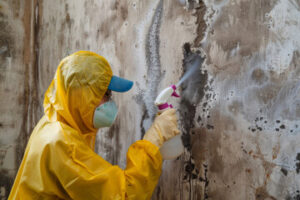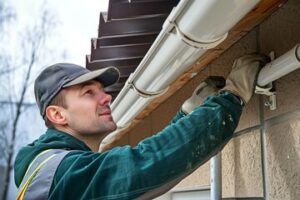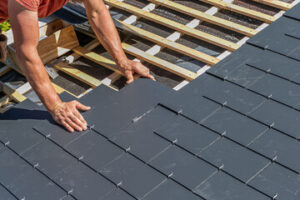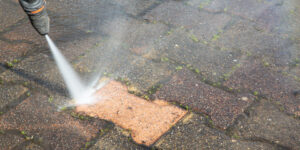Mold Removal Provo includes scrubbing surfaces to remove the physical growth, and treating them with a fungicidal solution. This kills the mold, and minimizes health risks.

It also involves drying wet materials as quickly as possible, using fans and dehumidifiers. Porous items like drywall, paper and carpet should be bagged and thrown away.
While mold spores are all around us, some individuals have a greater sensitivity to them than others. This sensitivity increases with prolonged exposure and can lead to respiratory, immune or neurologic symptoms. Chronic exposure can also result in a more serious condition called chronic inflammatory response syndrome (CIRS), which affects the entire body and can be life-threatening.
If you or someone in your family suffers from CIRS, contact a specialist to help find the root cause and treat it effectively. In the meantime, you can take steps to reduce the amount of mold in your home. Increasing airflow, reducing humidity and scrubbing surfaces can all contribute to the prevention of future mold growth.
Before beginning any cleanup or remediation project, it’s important to make sure that the area is safe to work in. This means ensuring that all workers wear personal protective equipment, and that they are aware of the risks associated with mold exposure. This includes masks, gloves and goggles, as well as a thorough cleaning process. It’s also important to isolate affected areas to prevent spores from spreading from one area to another, and to ensure that any materials that cannot be cleaned are safely disposed of.
A basic mold removal solution involves distilled white vinegar, which is effective at removing over 80% of the most common species of mold. This natural, non-toxic option is safe and easy to use. You can use it in a spray bottle or mix it with water to create a foaming action. Its smell can be unpleasant, but it will dissipate over time.
Using a clear ammonia cleaner can also be a good way to remove mold. However, it is important to remember that this product must be used only as directed and never combined with bleach. It is best to apply it to the surface of the mold, and then scrub with a sponge or brush to ensure that the root is killed. This product can be purchased in the cleaning aisle of your local department store.
It is important to note that mold spores can be found in many different types of items, and it is impossible to completely eliminate them from the environment. As such, it is always a good idea to regularly clean your clothes and linens with borax soap, as well as to remove any cellulose-based items, such as furniture, rugs or papers, from the affected area.
Chemicals
Mold removal professionals use a variety of chemical solutions in addition to physical removal to clean and kill mold. Generally, mold treatment uses chemicals like fungicides to eliminate surface-level growth and prevent it from returning. However, these methods don’t address the underlying issues that caused the mold growth in the first place. For example, mold often accompanies water damage and if the leak isn’t fixed, the spores will return when the conditions are right.
Fungicides are commonly used by mold removal companies, but they’re not ideal for the environment or your health. They can contaminate the air, irritate skin and eyes and create toxic vapors in water. Many of these chemical products are also harmful to wildlife and if they seep into groundwater, they can cause serious problems for the local ecosystem.
The National Standard for Mold Remediation calls for physical removal and fixing the underlying problem of moisture. Many remediators mist or fog surfaces with disinfectants or sanitizers to “kill” mold spores, but the spores and hyphal fragments will still be present in the air. The body can’t tell the difference between live and dead spores and will still respond to them as allergens.
Using natural cleaning products like vinegar and baking soda can help to reduce the amount of toxins in your home. However, if the problem is extensive, or if it continues to grow after cleaning, professional assistance should be sought.
A professional company will be able to determine the root causes of the problem and fix them so that the mold isn’t likely to come back. This may involve repairing drywall or installing a new ventilation system.
If you have allergies or other health problems, it is important to get a mold inspection as soon as possible. Symptoms can include coughing, itching and respiratory problems. Mold can be hidden behind walls and in air ducts and is difficult to spot with a naked eye. Professionals have specialized tools to locate and remove mold from all parts of your home. They can also assess your property and advise you on the best options to protect your health and the value of your home.
Natural cleaners
A variety of natural cleaners can be used to clean mold. These include vinegar, baking soda, hydrogen peroxide and more. These cleaners work well on non-porous surfaces, such as tiles and countertops. They are also good for removing mildew. To use these cleaners, make sure you are working in a well-ventilated area. If possible, open windows and use fans to help vent the air. You should also wear gloves, a face mask and safety glasses. These will protect you from the chemical fumes and skin contact with the cleaning solution. You should also test the cleaner on an inconspicuous part of the surface to ensure it does not damage the material.
Vinegar is an inexpensive, effective, natural cleaner that can kill mold spores and prevent them from returning. To use vinegar, mix equal parts of water and vinegar in a spray bottle and apply to the moldy surface. The mixture should be thick enough to stay on the surface, but not so much that it drips or pools. Let it sit for an hour before scrubbing and rinsing the area.
Hydrogen peroxide can also be used to kill mold spores and prevent them form growing back. To use hydrogen peroxide, pour three percent solution into a spray bottle and apply it to the affected area. It will fizz when it comes into contact with the mold, indicating that it is working. After about 10 minutes, scrub and rinse the area. You should also sanitize your spray bottle after each use to prevent the spread of mold in your home.
Baking soda has antimicrobial properties that make it an effective household cleaner for killing mold and mildew. To use baking soda, mix it with water or a vinegar and water solution and spray on the affected area. Wait for 30 minutes before scrubbing and rinsing.
These natural cleaners are effective, cheap and safe to use. However, they may not be able to completely remove all of the mold. If mold is in a porous surface, such as drywall or wood, you may need to replace it entirely. To be on the safe side, it is best to have mold removed by an experienced professional.
Fungicides
When fungicides are used to treat mold, the spores are killed and do not have a chance to grow. However, the fungicide itself can be a risk to human health. Often, it contains dangerous chemicals and requires special protective clothing to use safely. If you are a homeowner with a mold problem, you should consult a professional to determine what needs to be done.
Fungicides are highly toxic to humans and may require a mask and gloves. It is recommended that they only be used by a trained professional or as a last resort in severe cases. It is also important to understand the long term effects of fungicides and how they can impact collection materials.
The first step in a treatment program should always be to try to remove the mold growth with non-chemical methods. The next step should be to modify the environment so that the mold will not grow. For example, it is important to ensure proper humidity control and that the area is properly ventilated.
If this is not possible, a fungicidal agent can be used to prevent the spread of mold. These chemicals should be carefully tested for their effect on collections. The fungicides should be used according to their label instructions. They should be diluted as directed and should be applied to the surface of a specimen.
In general, it is preferred to apply a fungicide with a water/alcohol mixture rather than an acetone/water mixture. The ethanol helps to reduce the toxicity of the fungicide. It is a good idea to wipe surfaces that are exposed after the application of fungicides with an ethanol-water solution, as this will help to reduce residual fungicide and will make the fungicide more effective in the future.



